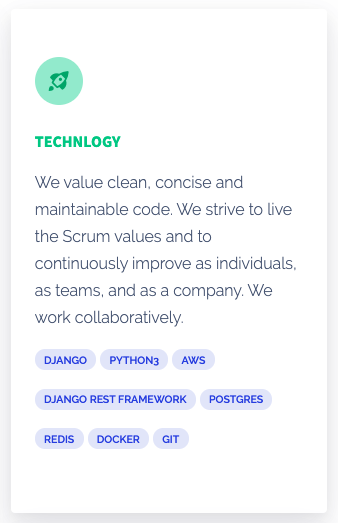
How do you write great job descriptions?
Job descriptions are key for attracting top talent to your company. And today, you learn how to write a GREAT job description that helps you target the best candidates.
Why Are Job Descriptions So Important?
As a startup or small- to medium-sized company, your job description is often the first time a candidate learns about your company and envisions themselves working there.
Once your job descriptions are well-executed, you will discover that a lot of your best applicants are inbound .
This means that candidates apply on their own after seeing one of your job posts instead of going through a recruiter or similar.
Inbound applications are amazing, because they save a whole lot of recruiting time in the long run (less time spent finding talented strangers and selling them on your openings.)
In fact, it's worth spending a bit of extra time up front writing awesome job descriptions to then get people applying on their own.
In this article, you will learn how to easily use best practices in your job posts and increase your quantity and quality of inbound applications.
Let’s get started!
1. Determine the appropriate job title
To begin, you should spend some time thinking about what to call the open position.
Often, the most obvious title is the best choice.
If the role is open because you’re replacing someone, don’t assume that you need to carry over their old title.
Choose the job title that is commonly used and easy to understand over something obscure. If you need inspiration, try researching comparable openings to discover how competitors are titling the role.
The highest performing job titles typically contain 1–3 words (e.g. Senior Project Manager, Data Science Engineer, HR Generalist, Accountant, etc.)
Try to keep it short and sweet: the total length of a job title should never exceed 40 characters.
What not to do:
Don’t use highly specific industry jargon
Don’t use symbols in the title (!, %, $, etc.)
Don’t use bizarre phrases like “ninja” or “rockstar”
2. Craft a compelling job description
The job description itself should be a short paragraph that draws potential talent in. If you’re going to be creative at any point in the job post, now is the time.
You should say a little about what you’re looking for, but your focus should be on selling the role.
What makes this opportunity great? How can a potential candidate develop themselves through the role? What can they master? What makes their work intrinsically rewarding? How will they fit into the team? How do they contribute to the company’s mission?
These are important questions to consider — and if possible, answer — in the job description.
After all, job descriptions that are between 700-2,000 words long get 30% more applicants.
3. List the job responsibilities
Now it's time to get into the nitty-gritty of the work they’ll be doing.
You should still try to be concise — try to limit this section to 7 bullet points. Focus on the responsibilities that you will base your evaluations on or test for in later interview phases.
Don’t put random stuff in here just because “typical” roles with the same title tend to do those things. Your list of responsibilities should be customized to your opening.
Organize responsibilities based on importance, putting the most crucial responsibilities at the top.
Don’t include pieces of information that are redundant.
For example, you do not need to include “manage the team” in the responsibilities section if you’ve already mentioned it in the job description.
4. Carefully consider the “Your Profile” section
The entire job description is designed for the candidate, but this is often the section they check out first. Why, after all, should you read the rest of the post if you don’t fit the profile?
A lot has been written about inclusive hiring. The takeaway for job descriptions is this: don’t create arbitrary requirements for your open roles.
What's arbitrary? Specific degrees (do you really need an MBA over an MA in Management?), specific number of years of experience (does something magic happen after 5 years in a role?), and gendered wording.
There are times where a specific degree or minimum experience is preferred or even required. In those cases, make it clear that it's necessary to do the job (e.g. architects, lawyers, doctors, etc.)
For every other role, try to keep it limited to what's actually needed to do the job, and let people self-select based on those criteria.
If you’re wondering what else to include in the profile section, why not try hiring for attitude? Include bullets that describe the attitudes of the type of person you’re looking for.
If you need someone who's good at teamwork and will have a lot of face time with clients, then an example could be “You enjoy working on teams and interacting directly with customers.”
5. Add in some flair
The title, job description, requirements, and profile sections make up the key components of a great job description, but adding a few extras will really take it above and beyond. Consider adding these sections as well, especially on your primary careers page.
Benefits and Compensation
Whether or not to add compensation bands to job descriptions is a bit of a contested topic, but the point is, the Google Job Search Engine’s algorithm (and sometimes your potential candidate) favors descriptions that do, so keep that in mind.
By listing salary in your description, you get 30% more applications. Doing so is a legal requirement in some states like California, Connecticut, Maryland, Nevada, Rhode Island, and Washington. Plus, if you’re paying above industry-average, why not flaunt it?
But compensation isn’t just the check you get every few weeks. If your company provides bonuses, equity, commission, vacation, personal development budget, team trips, gym membership, breakfast in the morning, or anything in addition to a steady paycheck, then you should include those too.
Benefits are a part of what makes your company a great place to work, and they should be super apparent to all candidates that stumble across your job post.
Tech Stack
For technical roles, it's important that you include your company’s tech stack somewhere in the job description. You can do that by including the languages, frameworks, and technologies that you expect candidates to be proficient in as requirements.
Another option is to include a box or section with your tech stack front-and-center (we have a designated space for this on CodeSubmit Talent!) Making this information obvious and easily accessible allows developer talent to quickly determine if they’re a fit for the role.

5. Communicate the next steps
In today’s increasingly competitive talent market, time-to-hire is crucial to successful hiring. You should know well in advance what your end-to-end hiring process looks like before posting open roles. So why not share that process with candidates? Doing so in a “next steps” section will set expectations for potential candidates and help them prepare to excel in later stages.
Try CodeSubmit for free today (no credit card required).